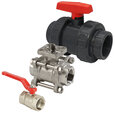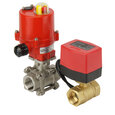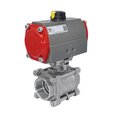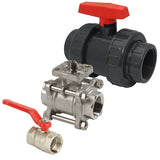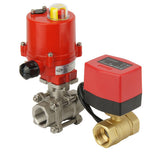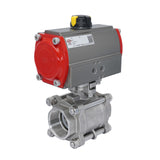Ball Valve Handle Information and Replacement
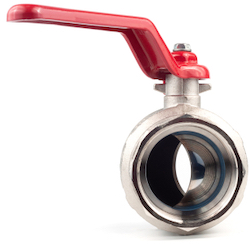
Figure 1: Ball valve with a lever-type handle
Ball valve handles serve as the interface for users to easily open and close ball valves in fluid systems. The position of the handle indicates whether the valve is open or closed; for instance, a lever handle aligned with the flow path signifies that the valve is open. This article discusses the various types of ball valve handles and the ball valve handle replacement procedure.
Table of contents
- Ball valve handle types comparison
- Lever handles
- Hand wheel
- Butterfly handle
- Screw slot handle
- How to replace a ball valve handle
- FAQs
View our online selection of ball valves!
Ball valve handle types comparison
Table 1: Ball valve handle types
| Handle type | Advantages | Disadvantages | When to use | Image |
| Lever handle | Quick 90-degree operation, clear open/closed indication | Requires space to turn, not ideal for larger valves | Quick shut-off in residential and industrial applications | 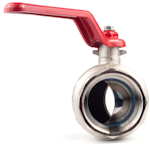 |
| Hand wheel | Precise flow control, comfortable grip | Labor-intensive for large sizes, needs vertical clearance | Precise flow adjustment in large, high-pressure ball valves | 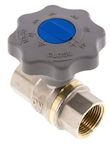 |
| Butterfly handle | Compact and quick operation, allows controlled adjustments | Limited to smaller valves, less leverage than lever handles | Tight spaces, precise flow control in small valves | 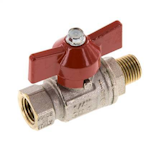 |
| Screw slot handle | Extremely compact and lightweight | Inconvenient for frequent use, no visual position indicator | Space-limited installations involving infrequent adjustments | 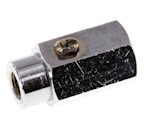 |
Lever handles
A lever handle has a long arm (lever) connected to the valve stem. It is the most common handle type used in ball valves. A lever handle provides a simple mechanism for opening and closing the valve with a 90-degree (quarter) turn. The handle indicates the state of a ball valve: when the handle is aligned with the pipe, the valve is open, and when it is perpendicular, the valve is closed.
Hand wheel
Hand wheels are circular handles that require multiple rotations to open or close the valve. They provide precise control over flow. Rotating the hand wheel by 360 degrees will open or close the valve. The handwheel is scaled to indicate the valve position.
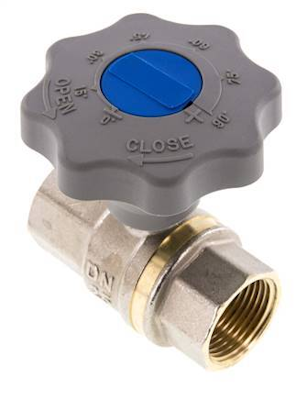
Figure 2: Ball valve with a scaled hand wheel
Butterfly handle
Butterfly handles are suitable for applications where precise adjustment of flow rates is needed, especially in smaller valve sizes where lever handles are not practical. Their soft-close feature allows for a gradual, controlled operation, minimizing risks like water hammer, ignition, or shock in sensitive systems. This makes them ideal for gas applications where sudden pressure changes must be avoided.
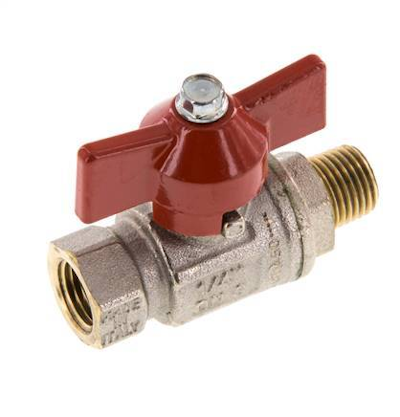
Figure 3: Brass ball valve with a butterfly handle
Screw slot handle
A screw slot is not a traditional handle. It's a design used in ball valves, where the valve is operated using a screwdriver instead of a conventional handle. Choose screw slot handles when space is limited, and the valve does not require frequent adjustments.
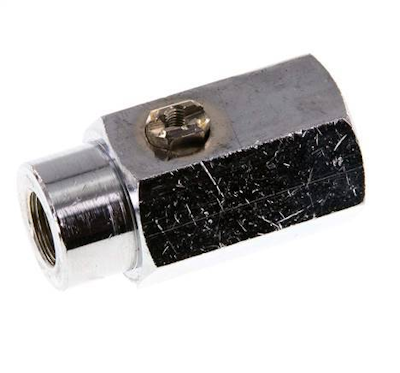
Figure 4: Screwdriver operated brass ball valve
Note: The flow through a ball valve is not linear, meaning small changes in the valve position can result in significant changes in flow rate. This non-linear behavior can make precise flow control challenging. A standard ball valve's design is not optimized for throttling. The potential for cavitation and erosion still exists if the valve is used in a partially open position for extended periods. For applications requiring continuous throttling, characterized ball valves are recommended.
How to replace a ball valve handle
Ball valve handles may need to be replaced due to mechanical damage, such as breakage or rust beyond repair, and operational issues, like difficulty in opening or closing the valve. Here’s a step-by-step guide on how to replace ball valve handles.
Materials needed
- Replacement handle (ensure compatibility with your valve model)
- Screwdriver or wrench (for screw-on handles)
- Safety gear (gloves, goggles)
Steps for replacing a push-on type handle
- Shut off fluid supply: Ensure the main fluid supply to the valve is turned off to prevent leaks or spills.
- Remove the old handle: Firmly grip the existing handle and pull it upwards until it pops off the valve stem.
- Install the new handle: Align the new handle with the valve stem and press down firmly until it snaps into place.
Steps for replacing a screw-on type handle
- Shut off fluid supply: Turn off the main fluid supply to the valve.
- Remove the old handle: Use a screwdriver or wrench to remove the screw or nut securing the handle to the valve stem. Once loosened, remove the handle from the stem.
- Install the new handle: Position the new handle onto the valve stem. Secure it by tightening the screw or nut with a screwdriver or wrench.
Additional considerations
- Valve stem leaks: If you notice a leak from the valve stem, the valve packing may need replacement.
- Model compatibility: Knowing the valve’s model number can help find the correct replacement handle.
- Cost efficiency: Consider replacing the entire valve if a suitable handle is unavailable.
-
Handle materials: Consider the operating environment, media compatibility, and budget when choosing a ball valve handle.
- Stainless steel is ideal for outdoor or corrosive environments due to its excellent corrosion resistance.
- If cost is a concern, materials like die-cast zinc or polyamide offer a balance of performance and affordability.
FAQs
Can you change the handle on a ball valve?
You can change a ball valve handle if it is broken or corroded beyond repair.
How to remove ball valve handle?
First, to remove a ball valve handle, ensure the fluid supply is off. For a push-on handle, pull it straight off the valve stem. If it's secured with a screw, use a screwdriver to remove the screw, then lift the handle off.
Can you reverse a ball valve handle?
Yes, you can reverse a ball valve handle if the design allows it. Turn off the fluid supply, remove the handle by unscrewing or pulling it off, and reattach it in the desired orientation.
How to replace a PVC ball valve handle?
For a push-on handle, pull it off and snap the new one in place. If secured with a screw, remove the screw, replace the handle, and tighten the screw.
Which way should a ball valve handle face?
A ball valve handle should align with the pipe when open and be perpendicular when closed.
How can I fix a stuck ball valve?
Spray lubricant like WD-40 where the handle meets the valve, wait 20 minutes, then gently tap with a hammer if stuck.
What tools are needed for PVC ball valve handle replacement?
You may need a screwdriver if the handle is secured with a screw; otherwise, no tools are required in a push-on handle.




